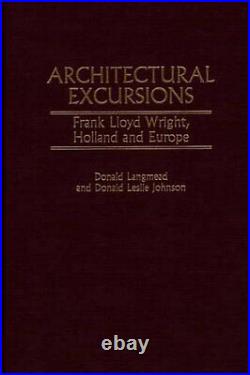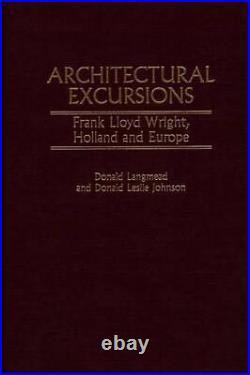By Donald Langmead, Donald L. Provides insight into the effects of Frank Lloyd Wright’s architectural theories and designs in Holland and Europe in the 1920s. It covers events and theories, including the assertion that Hendrik Theodor Wijdeveld was the catalytic source behind Wright’s Taliesin Fellowship established in 1932. Soon after 1900 in both North America and Europe the evolution from the tradition of Mediterranean and Gallic architectural styles to modernism began. This phenomenon was due, in part, to American industrial architecture and the work of Frank Lloyd Wright. European architecture within and outside of Holland reflects an adaptation of Wright’s theories along with the structural determinism of American industrial buildings. With new evidence and fresh analysis culled from Dutch and American archives, personal correspondence, and professional material, this study examines the weight of Wright’s works and words and those of the Dutchmen H. Berlage, Theo van Doesburg, Jan Wils, J. Oud, William Dudok, and Hendrik Theodor Wijdeveld. This new insight on the effects of Wright’s architectural theories and designs, coupled with an extensive guide for further research, will attract art and architecture scholars and historians on both sides of the Atlantic and will also be of interest to social historians, artists, and architects. Events and new theories, including the assertion that Hendrik Theodor Wijdeveld was the catalytic source behind Wright’s Taliesin Fellowship established in 1932, are presented in clear accessible language. Tied to the text are numerous visual presentations of significant designs and buildings. DONALD LANGMEAD is Professor of Architectural History at the University of South Australia. His previous books concerning modern architecture include Makers of 20th Century Modern Architecture (Greenwood, 1997), coauthored with Donald Leslie Johnson, Willem Marinus Dudok, A Dutch Modernist (Greenwood, 1996), Dutch Modernism (Greenwood, 1996), and J. Oud and the International Style (Greenwood, 1999). DONALD LESLIE JOHNSON is an American scholar who studied in the masters class of Louis Kahn. He is an Adjunct Associate Professor at the University of South Australia. He founded the Architectural Studies Program at Flinders University in Adelaide, South Australia and the Architecture Archives, of which he is Director, at the University of South Australia. Along with Donald Langmead he coauthored Makers of 20th Century Modern Architecture (Greenwood, 1997). His other works on Wright include Frank Lloyd Wright Versus America: The 1930s (1990). Donald Langmead, Donald L. Grand Eagle Retail is the ideal place for all your shopping needs! We are unable to deliver faster than stated. International deliveries will take 1-6 weeks. Please contact Customer Services and request “Return Authorisation” before you send your item back to us. We cannot take responsibility for items which are lost or damaged in transit. Home, Garden & Pets.
Posts tagged langm
By Donald Langmead, Donald L. Provides insight into the effects of Frank Lloyd Wright’s architectural theories and designs in Holland and Europe in the 1920s. It covers events and theories, including the assertion that Hendrik Theodor Wijdeveld was the catalytic source behind Wright’s Taliesin Fellowship established in 1932. Soon after 1900 in both North America and Europe the evolution from the tradition of Mediterranean and Gallic architectural styles to modernism began. This phenomenon was due, in part, to American industrial architecture and the work of Frank Lloyd Wright. European architecture within and outside of Holland reflects an adaptation of Wright’s theories along with the structural determinism of American industrial buildings. With new evidence and fresh analysis culled from Dutch and American archives, personal correspondence, and professional material, this study examines the weight of Wright’s works and words and those of the Dutchmen H. Berlage, Theo van Doesburg, Jan Wils, J. Oud, William Dudok and Hendrik Theodor Wijdeveld. Events and theories, including the assertion that Hendrik Theodor Wijdeveld was the catalytic source behind Wright’s Taliesin Fellowship established in 1932, are presented in clear accessible language. Tied to the text are numerous visual presentations of significant designs and buildings. Donald Langmead is Professor of Architectural History at the University of South Australia. Donald Leslie Johnson is an American scholar who studied in the masters class of Louis Kahn. Foreword by Niels Luning PrakPrefaceFin de Siècle TurmoilDiscoveryImmediate ReactionInsights: Jan WilsSerious Looks, Passing GlancesWijdeveld: A Bright ProspectWijdeveld: Eye to EyeThe ShowTurningsFellowshipMany FellowshipsWijdeveld in AmericaSixty Years of Living ArchitectureAppendix A: Some Wright-Influenced Buildings in The NetherlandsAppendix B: Wright to Wijdeveld, 21 October 1947Appendix C: Wijdeveld’s An International Guide, Santpoort, 1931Appendix D: The Taliesin Fellowship Constitution, 1932NotesBibliographyIndex of Personal Names. A study presenting new material about Frank Lloyd Wright’s influential role in the development of modern architecture in Holland and Europe in the 1920s. Oud, William Dudok, and Hendrik Theodor Wijdeveld. This new insight on the effects of Wright’s architectural theories and designs, coupled with an extensive guide for further research, will attract art and architecture scholars and historians on both sides of the Atlantic and will also be of interest to social historians, artists, and architects. Events and new theories, including the assertion that Hendrik Theodor Wijdeveld was the catalytic source behind Wright’s Taliesin Fellowship established in 1932, are presented in clear accessible language. Short Title ARCHITECTURAL EXCURSIONS. Subtitle Frank Lloyd Wright, Holland and Europe. Country of Publication United States. Place of Publication Westport. Imprint Praeger Publishers Inc. UK Release Date 2000-08-30. AU Release Date 2000-08-30. NZ Release Date 2000-08-30. US Release Date 2000-08-30. Publisher Bloomsbury Publishing Plc. Series Contributions to the Study of Art and Architecture. We’ve got this. At The Nile, if you’re looking for it, we’ve got it.

